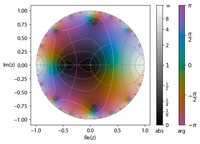Lambert series

Okay kiddo, do you know what numbers are? They're like 1, 2, 3, 4, 5, and so on.
Now, there is something called a Lambert series, which is a way of adding up a lot of different numbers in a specific way.
Let's imagine we have a big bag full of numbers, like 1, 2, 3, 4, 5, and so on, all the way to infinity.
A Lambert series tells us to add up all the numbers in the bag that have a special relationship with a certain number that we choose. This number is called the "base" of the series.
For example, let's choose 2 as our base. We want to add up all the numbers in the bag that are multiples of 2, like 2, 4, 6, 8, and so on.
But we don't just add up those exact numbers. We use a special formula to add them up. The formula goes like this:
2 + 4/2^2 + 6/2^3 + 8/2^4 + 10/2^5 + ...
It might look a bit confusing, but let's break it down.
The first number we add is just 2, since it's the first multiple of 2 in the bag.
Then, we look at the next multiple of 2, which is 4. But we don't just add 4 to our total. We divide it by 2^2, which is 4. So we get 4/4, which simplifies to 1.
Next up is 6, another multiple of 2. We divide it by 2^3, which is 8, to get 6/8.
We keep doing this for all the multiples of 2 in the bag, dividing each one by a higher power of 2 each time.
The end result is called the Lambert series for 2, and it looks like this:
2 + 1 + 3/4 + 1/2 + 5/32 + ...
Pretty cool, huh? We can do this same thing with any other number as a base, and we'll get a different Lambert series.
Lambert series are used in lots of different areas of math, like number theory and complex analysis. But for now, we can just appreciate the fact that we can add up a bunch of numbers in a cool new way!
Now, there is something called a Lambert series, which is a way of adding up a lot of different numbers in a specific way.
Let's imagine we have a big bag full of numbers, like 1, 2, 3, 4, 5, and so on, all the way to infinity.
A Lambert series tells us to add up all the numbers in the bag that have a special relationship with a certain number that we choose. This number is called the "base" of the series.
For example, let's choose 2 as our base. We want to add up all the numbers in the bag that are multiples of 2, like 2, 4, 6, 8, and so on.
But we don't just add up those exact numbers. We use a special formula to add them up. The formula goes like this:
2 + 4/2^2 + 6/2^3 + 8/2^4 + 10/2^5 + ...
It might look a bit confusing, but let's break it down.
The first number we add is just 2, since it's the first multiple of 2 in the bag.
Then, we look at the next multiple of 2, which is 4. But we don't just add 4 to our total. We divide it by 2^2, which is 4. So we get 4/4, which simplifies to 1.
Next up is 6, another multiple of 2. We divide it by 2^3, which is 8, to get 6/8.
We keep doing this for all the multiples of 2 in the bag, dividing each one by a higher power of 2 each time.
The end result is called the Lambert series for 2, and it looks like this:
2 + 1 + 3/4 + 1/2 + 5/32 + ...
Pretty cool, huh? We can do this same thing with any other number as a base, and we'll get a different Lambert series.
Lambert series are used in lots of different areas of math, like number theory and complex analysis. But for now, we can just appreciate the fact that we can add up a bunch of numbers in a cool new way!
Related topics others have asked about:
